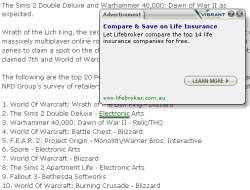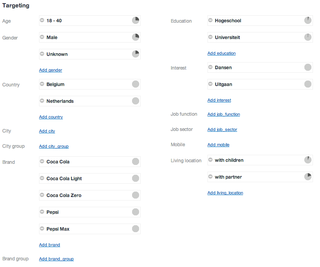Related Research Articles

Pop-up ads or pop-ups are forms of online advertising on the World Wide Web. A pop-up is a graphical user interface (GUI) display area, usually a small window, that suddenly appears in the foreground of the visual interface. The pop-up window containing an advertisement is usually generated by JavaScript that uses cross-site scripting (XSS), sometimes with a secondary payload that uses Adobe Flash. They can also be generated by other vulnerabilities/security holes in browser security.
Digital display advertising is online graphic advertising through banners, text, images, video, and audio. The main purpose of digital display advertising is to post company ads on third-party websites. A display ad is usually interactive, which allows brands and advertisers to engage deeper with the users. A display ad can also be a companion ad for a non-clickable video ad.
Google AdSense is a program run by Google through which website publishers in the Google Network of content sites serve text, images, video, or interactive media advertisements that are targeted to the site content and audience. These advertisements are administered, sorted, and maintained by Google. They can generate revenue on either a per-click or per-impression basis. Google beta-tested a cost-per-action service, but discontinued it in October 2008 in favor of a DoubleClick offering. In Q1 2014, Google earned US$3.4 billion, or 22% of total revenue, through Google AdSense. In 2021, more than 38 million websites used AdSense. It is a participant in the AdChoices program, so AdSense ads typically include the triangle-shaped AdChoices icon. This program also operates on HTTP cookies.
Pay-per-click (PPC) is an internet advertising model used to drive traffic to websites, in which an advertiser pays a publisher when the ad is clicked.

Banner blindness is a phenomenon in web usability where visitors to a website consciously or unconsciously ignore banner-like information. A broader term covering all forms of advertising is ad blindness, and the mass of banners that people ignore is called banner noise.
An online advertising network or ad network is a company that connects advertisers to websites that want to host advertisements. The key function of an ad network is an aggregation of ad supply from publishers and matching it with the advertiser's demand. The phrase "ad network" by itself is media-neutral in the sense that there can be a "Television Ad Network" or a "Print Ad Network", but is increasingly used to mean "online ad network" as the effect of aggregation of publisher ad space and sale to advertisers is most commonly seen in the online space. The fundamental difference between traditional media ad networks and online ad networks is that online ad networks use a central ad server to deliver advertisements to consumers, which enables targeting, tracking and reporting of impressions in ways not possible with analog media alternatives.
Online advertising, also known as online marketing, Internet advertising, digital advertising or web advertising, is a form of marketing and advertising that uses the Internet to promote products and services to audiences and platform users. Online advertising includes email marketing, search engine marketing (SEM), social media marketing, many types of display advertising, and mobile advertising. Advertisements are increasingly being delivered via automated software systems operating across multiple websites, media services and platforms, known as programmatic advertising.
Click-through rate (CTR) is the ratio of clicks on a specific link to the number of times a page, email, or advertisement is shown. It is commonly used to measure the success of an online advertising campaign for a particular website, as well as the effectiveness of email campaigns.
Contextual advertising is a form of targeted advertising for advertisements appearing on websites or other digital platforms, such as content displayed in mobile browsers. Contextual targeting involves the use of linguistic factors to control the placement of advertising material. The advertisements are selected and delivered by automated systems, taking into consideration the context of a user's search or browsing behaviour. As advertisers and marketers increasingly prioritise brand safety and suitability, contextual advertising has emerged as a crucial aspect in safeguarding the reputation and value of a brand.

IntelliTXT is a keyword advertising platform developed by Vibrant Media. Web page publishers insert a script into their pages which calls the IntelliTXT platform when a viewer views the page. This script then finds keywords on the page and double underlines them. When holding the mouse over the double underlined link, an advertisement associated with that word will pop up. Advertisers pay to have their particular words associated to their advertisements.
Keyword advertising is a form of online advertising in which an advertiser pays to have an advertisement appear in the results listing when a person uses a particular phrase to search the Web, typically by employing a search engine. The particular phrase is composed of one or more key terms that are linked to one or more advertisements. The most common form or keyword advertising, focused on payment methods, is pay per click (PPC), with other forms being cost per action (CPA) or cost per mille (CPM).
In Internet marketing, search advertising is a method of placing online advertisements on web pages that show results from search engine queries. Through the same search-engine advertising services, ads can also be placed on Web pages with other published content.
Mobile advertising is a form of advertising via mobile (wireless) phones or other mobile devices. It is a subset of mobile marketing, mobile advertising can take place as text ads via SMS, or banner advertisements that appear embedded in a mobile web site.
Website monetization is the process of converting existing traffic being sent to a particular website into revenue. The most popular ways of monetizing a website are by implementing pay per click (PPC) and cost per impression (CPI/CPM) advertising. Various ad networks facilitate a webmaster in placing advertisements on pages of the website to benefit from the traffic the site is experiencing.

Targeted advertising or data-driven marketing is a form of advertising, including online advertising, that is directed towards an audience with certain traits, based on the product or person the advertiser is promoting.

In-text advertising is a form of contextual advertising where specific keywords within the text of a web-page are matched with advertising and/or related information units.
InMobi is an Indian multinational technology company, based in Bangalore. Its mobile-first platform allows brands, developers and publishers to engage consumers through contextual mobile advertising. The company was founded in 2007 under the name mKhoj by Naveen Tewari, Mohit Saxena, Amit Gupta and Abhay Singhal.
Namo Media was a technology startup providing in-stream advertisements for mobile applications. It was acquired by Twitter in June 2014 for between $50M and $100M.

Adtile Technologies is an American company that develops and markets motion-sensing technology. The company’s headquarter is in San Diego, California. It is best known for its motion ads, which employs phone's sensors that supports motion as input to make advertisements interactive.

Advertising revenue is the monetary income that individuals and businesses earn from displaying paid advertisements on their websites, social media channels, or other platforms surrounding their internet-based content. In September 2018, the U.S Internet advertising market was estimated to be worth $111 billion, with market share being held mostly between Google, Facebook, Amazon, and Microsoft. These companies earn revenue through online advertising but also have initiated pathways for individual users and social media influencers to earn an income. Individuals and businesses can earn advertising revenue through advertising networks such as Google AdSense, YouTube monetization, or Outbrain.
References
- ↑ Mei T, Hua X, & Li S (2008). Contextual In-image Advertising. In Proceedings of the 16hth ACM International Conference on Multimedia, 439-448.
- ↑ Saint N (April 7, 2010). Ex AOLer Joins Startup That Wants To Put Ads In Images All Over The Internet. Business Insider
- ↑ "Google Bets on Startup's 'Photo-Based AdSense' - InternetNews". www.internetnews.com.
- ↑ Michael Arrington (February 13, 2008) . "GumGum Launches New Image Licensing Platform".
- ↑ Michael Arrington (September 8, 2008) DemoPit Company: Picad Media. TechCrunch 50 2008.
- ↑ Anthony Ha (January 19, 2012) Vibrant Media Boosts In-Image Ads With Acquisition
- ↑ Stephen Harvey (October 13, 2014) Archived 2014-10-16 at the Wayback Machine . Advant Technology 51 2014.
- ↑ http://www.iab.net/media/file/INIMAGEADVERTISINGBUYERSGUIDE.pdf [ bare URL PDF ]
- ↑ "NetSeer Sees Potential of Links for In-Image Monetization". 4 August 2014. Archived from the original on 8 August 2014. Retrieved 20 October 2014.
- ↑ "Seedtag, the ex-Googler-founded, cookie-free, AI-based adtech startup, taps $250M+ in funding". TechCrunch. Retrieved 2022-07-31.